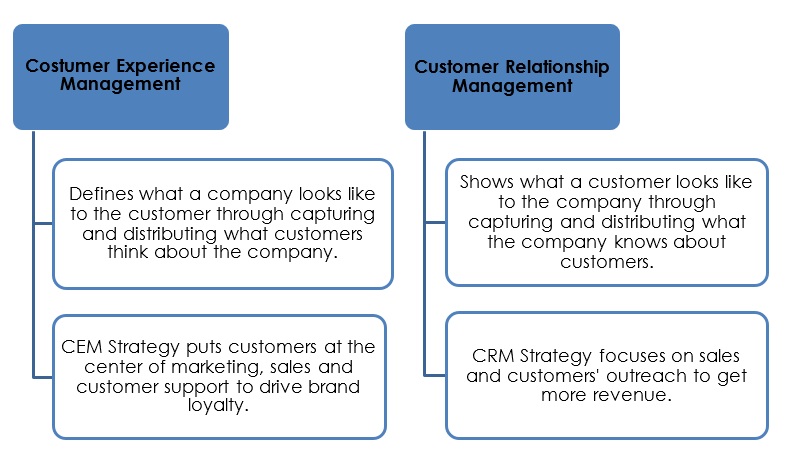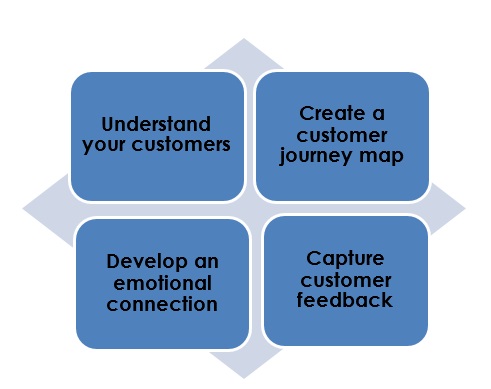Course Content
1. Marketing and Sales
2. Customer Experience
3. Conclusion
As we stated at the beginning of the material, marketing and sales represent two business function within an organisation, that determine the lead generation and revenue generation. While marketing in characteriszed by the process of getting people’s attention regarding a product or a service, sales represent the activities that need to be done in order to sell that product or service (Hart, 2019). What you should remember as a difference between marketing and sales is the fact that marketing is responsible forwith the development of a strategy, while sales isare responsible forwith the implementation of the strategy (Funk, s.n.). Another important differences between marketing and sales isare the following: marketing is interested inby the needs and desires of the customer, while sales are interested inby the needs of the seller; marketing views business as a consumer satisfying process, while sales views business as a goods producing and selling process (Jena, 2020). We also talked about online marketing and e-commerce and we learned that online marketing represents the practice of promoting a product orf a service via the internet, using channels like E-mail, Facebook, YouTube and so on. On the other hand, e-commerce represents the buying and selling process of goods and services, or the transmission of funds or data through an electronic network, especially the Internet. This guide has been realiszed in order to develop new skills, knowledge and competencies for women in rural areas, but also to increase the entrepreneurial opportunities and the employment ones for them. The chapter related to “customer experience” which contains the definitions of this concept, the differences between the two concepts, “customer service” and “customer experience” but also some ideas of how to manage the customers’ experience, wanted to bring to the forefront important knowledge about this subject, especially for the target group. Therefore, this concept is a very important one, especially for those who want to open a business, because this information can help them to attract as many customers as possible but also to be able to maintain them for a long period of time in order to develop the business more and more. Moreover, we hope that women from rural areas are really helped by this chapter, but also by this guide and we hope that the employment rate among them and also the number of women entrepreneurs will increase in the near future.
How to manage the customers’ experience
For a company or a brand to be successful, it must know how to manage the customers’ experience.
There is not one single definition for the customer experience management, so below you will see some short definitions of this concept, in order to better understand it.
Customer experience management (CEM or CXM) represents:
- the company’s strategy in order to control the customers’ perceptions;
- a collection of processes that a company uses in order to organise and track every interaction between the customers and the company;
- a discipline that helps understanding customers and implementing strategic plans;
- a practice of creating and reacting to customer interactions in order to meet or exceed the customers’ expectations, which have to lead to greater satisfaction and loyalty from the customers.
As “customer experience” looks similar with “customer service”, customer experience management (CEM) may look similar with customer relationship management (CRM), but there are also some differences between the last two.

In order to manage customer experience, a company or a brand should have a 360-degree view of customers and also up-to-date and integrated data on customer accounts. Moreover, it is important to create a customer experience strategy which has to be successful through following the four critical steps below:

Understand your customers – first step in building a customer experience strategy is understanding the needs and behaviors of the customers. The company can develop customer profiles and implement customer segmentation based on age, interests and other important factors.
Create a customer journey map – this helps the company to identify customer touchpoints, but also anticipate the customers’ interactions with the products and the services.
Develop an emotional connection – creating a brand personality which evokes emotions leads to a strong relationship between the customers and the company.
Capture customer feedback – customer feedback is important for the company because it helps tracking customer perceptions but also measuring the success of the customer experience strategy. Moreover, it is important to measure the satisfaction of the customers in real time.
In order to manage customer experience along the entire customer journey, a company has to apply the following techniques and strategies:
- generating content;
- evaluating customer sentiment;
- creating customer personas and marketing segments;
- investing in customer loyalty programms;
- evaluating customer touchpoints;
- analysing customer data.
“Anything that the customer can interact with is part of the customer experience. You need to be managing that experience so that all of your teams are working together to provide a seamless, pleasant experience.”
(Dave Dyson, Senior Customer Service Evangelist, Zendesk)




